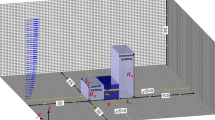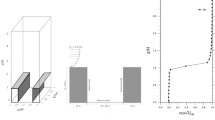Abstract
The impact of diurnal variations of the heat fluxes from building and ground surfaces on the fluid flow and air temperature distribution in street canyons is numerically investigated using the PArallelized Large-eddy Simulation Model (PALM). Simulations are performed for a 3 by 5 array of buildings with canyon aspect ratio of one for two clear summer days that differ in atmospheric instability. A detailed building energy model with a three-dimensional raster-type geometry—Temperature of Urban Facets Indoor-Outdoor Building Energy Simulator (TUF-IOBES)—provides urban surface heat fluxes as thermal boundary conditions for PALM. In vertical cross-sections at the centre of the spanwise canyon the mechanical forcing and the horizontal streamwise thermal forcing at roof level outweigh the thermal forces from the heated surfaces inside the canyon in defining the general flow pattern throughout the day. This results in a dominant canyon vortex with a persistent speed, centered at a constant height. Compared to neutral simulations, non-uniform heating of the urban canyon surfaces significantly modifies the pressure field and turbulence statistics in street canyons. Strong horizontal pressure gradients were detected in streamwise and spanwise canyons throughout the day, and which motivate larger turbulent velocity fluctuations in the horizontal directions rather than in the vertical direction. Canyon-averaged turbulent kinetic energy in all non-neutral simulations exhibits a diurnal cycle following the insolation on the ground in both spanwise and streamwise canyons, and it is larger when the canopy bottom surface is paved with darker materials and the ground surface temperature is higher as a result. Compared to uniformly distributed thermal forcing on urban surfaces, the present analysis shows that realistic non-uniform thermal forcing can result in complex local airflow patterns, as evident, for example, from the location of the vortices in horizontal planes in the spanwise canyon. This study shows the importance of three-dimensional simulations with detailed thermal boundary conditions to explore the heat and mass transport in an urban area.














Similar content being viewed by others
References
Akbari H, Rainer L (2000) Measured energy savings from the application of reflective roofs in 3 AT&T regeneration buildings. Lawrence Berkeley National Laboratory, Paper LBNL-47075
Allegrini J, Dorer V, Carmeliet J (2013) Wind tunnel measurements of buoyant flows in street canyons. Build Environ 59:315–326
American Concrete Pavement Association (2011) Albedo: a measure of pavement surface reflectance. http://www.pavement.com/Downloads/RT/RT3.05.pdf. Accessed 15 Dec 2011
American Society of Heating, Refrigerating and Air-Conditioning Engineers Inc. (2004) ANSI/ASHRAE/IESNA Standard 90.1-2004. Energy Standard for Buildings Except Low-Rise Residential Buildings I-P Edition
ASHRAE (1981) 1981 ASHRAE Handbook—Fundamentals. American Society of Heating, Refrigerating, and Air-Conditioning Engineers Inc, Atlanta
Berg R, Quinn W (1978) Use of light colored surface to reduce seasonal thaw penetration beneath embankments on permafrost. In: Proceedings of the second international symposium on cold regions engineering, University of Alaska, pp 86–99
Boppana VBL, Xie ZT, Castro IP (2013) Large-eddy simulation of heat transfer from a single cube mounted on a very rough wall. Boundary-Layer Meteorol 147(3):347–368
Bouyer J, Inard C, Musy M (2011) Microclimatic coupling as a solution to improve building energy simulation in an urban context. Energy Build 43:1549–1559
Cai XM (2012) Effects of wall heating on flow characteristics in a street canyon. Boundary-Layer Meteorol 142(3):443–467
Castillo MCL, Kanda M, Letzel MO (2009) Heat ventilation efficiency of urban surfaces using large-eddy simulation. Ann J Hydraulic Eng 53:175–180
Cheng H, Castro IP (2002) Near wall flow over urban-like roughness. Boundary-Layer Meteorol 104(2):229–259
Cheng WC, Liu CH, Leung DYC (2009) On the correlation of air and pollutant exchange for street canyons in combined wind-buoyancy-driven flow. Atmos Environ 43:3682–3690
Coceal O, Dobre A, Thomas TG, Belcher SE (2007) Structure of turbulent flow over regular arrays of cubical roughness. J Fluid Mech 589:375–409
Deardorff JW (1980) Stratocumulus-capped mixed layers derived from a three-dimensional model. Boundary-Layer Meteorol 18:495–527
Dimitrova R, Sini JF, Richards K, Schatzmann M, Weeks M, García EP, Borrego C (2009) Influence of thermal effects on the wind field within the urban environment. Boundary-Layer Meteorol 131(2):223–243
Doulos L, Santamouris M, Livada I (2004) Passive cooling of outdoor urban spaces, the role of materials. Sol Energy 77:231–249
Eliasson I, Offerle B, Grimmond CSB, Lindqvist S (2006) Wind fields and turbulence statistics in an urban street canyon. Atmos Environ 40:1–16
Idczak M, Mestayer P, Rosant JM, Sini JF, Violleau MV (2007) Micrometeorological measurements in a street canyon during the joint ATREUS-PICADA experiment. Boundary-Layer Meteorol 124:25–41
Inagaki A, Kanda M (2010) Organized structure of active turbulence over an array of cubes within the logarithmic layer of atmospheric flow. Boundary-Layer Meteorol 135:209–228
Inagaki A, Castillo MCL, Yamashita Y, Kanda M, Takimoto H (2012) Large-eddy simulation of coherent flow structures within a cubical canopy. Boundary-Layer Meteorol 142(2):207–222
Kanda M, Moriwaki R, Kasamatsu F (2004) Large-eddy simulation of turbulent organized structures within and above explicitly resolved cube arrays. Boundary-Layer Meteorol 112:343–368
Kim JJ, Baik JJ (1999) A numerical study of thermal effects on flow and pollutant dispersion in urban street canyons. J Appl Meteorol 38:1249–1261
Kim JJ, Baik JJ (2001) Urban street-canyon flows with bottom heating. Atmos Environ 35:3395–3404
Kim JJ, Baik JJ (2010) Effects of street-bottom and building-roof heating on flow in three-dimensional street canyons. Adv Atmos Sci 28(3):513–527
Kitous S, Bensalem R, Adolphe L (2012) Airflow patterns within a complex urban topography under hot and dry climate in the Algerian Sahara. Build Environ 56:162–175
Kovar-Panskus A, Moulinneuf L, Savory E, Abdelqari A, Sini JF, Rosant JM, Robins A, Toy N (2002) A wind tunnel investigation of the influence of solar-induced wall-heating on the flow regime within a simulated urban street canyon. Water Air Soil Pollut Focus 2:555–571
Kwak KH, Baik JJ, Lee SH, Ryu YH (2011) Computational fluid dynamics modelling of the diurnal variation of flow in a street canyon. Boundary-Layer Meteorol 141(1):77–92
Lawrence Berkeley Laboratory (LBL) (1994) DOE2.1E-053 source code
Letzel MO, Krane M, Raasch S (2008) High resolution urban large-eddy simulation studies from street canyon to neighbourhood scale. Atmos Environ 42:8770–8784
Li XX, Britter RE, Norford LK, Koh TY, Entekhabi D (2012) Flow and pollutant transport in urban street canyons of different aspect ratios with ground heating: large-eddy simulation. Boundary-Layer Meteorol 142(2):289–304
Louka P, Vachon G, Sini JF, Mestayer PG, Rosant JM (2002) Thermal effects on the flow in a street canyon–Nantes’99 experimental results and model simulations. Water Air Soil Pollut Focus 2:351–364
Nakamura Y, Oke TR (1988) Wind, temperature and stability conditions in an east-west oriented urban canyon. Atmos Environ 22:2691–2700
Offerle B, Eliasson I, Grimmond CSB, Holmer B (2007) Surface heating in relation to air temperature, wind and turbulence in an urban street canyon. Boundary-Layer Meteorol 122:273–292
Park SB, Baik JJ (2013) A Large-eddy simulation study of thermal effects on turbulence coherent structures in and above a building array. J Appl Meteorol Climatol 52(6):1348–1365
Park SB, Baik JJ, Raasch S, Letzel MO (2012) A large-eddy simulation study of thermal effects on turbulent flow and dispersion in and above a street canyon. J Appl Meteorol Clim 51(5):829–841
Park SB, Baik JJ, Ryu YH (2013) A large-eddy simulation study of bottom-heating effects on scalar dispersion in and above a cubical building array. J Appl Meteorol Climatol 52(8):1738–1752
Pedersen CO, Liesen RJ, Strand RK, Fisher DE, Dong L, Ellis PG (2001) A toolkit for building load calculations; Exterior Heat Balance (CD-ROM). American Society of Heating Refrigerating and Air Conditioning Engineers (ASHRAE). Building Systems Laboratory
Perret L, Savory E (2013) Large-scale structures over a single street canyon immersed in an urban-type boundary layer. Boundary-Layer Meteorol 148(1):111–131
Raasch S, Schröter M (2001) PALM—a large-eddy simulation model performing on massively parallel computers. Meteorol Z 10:363–372
Richards K, Schatzmann M, Leitl B (2006) Wind tunnel experiments modelling the thermal effects within the vicinity of a single block building with leeward wall heating. J Wind Eng Ind Aerodyn 94(8):621–636
Rosenfeld AH, Akbari H, Bretz S, Fishman BL, Kurn DM, Sailor DJ, Taha H (1995) Mitigation of urban heat islands: materials, utility programs, updates. Energy Build 22:255–265
Shaw RH, Schumann U (1992) Large-eddy simulation of turbulent flow above and within a forest. Boundary-Layer Meteorol 61(1–2):47–64
Sini JF, Anquetin S, Mestayer PG (1996) Pollutant dispersion and thermal effects in urban street canyons. Atmos Environ 30:2659–2677
Solazzo E, Britter RE (2007) Transfer processes in a simulated urban street canyon. Boundary-Layer Meteorol 124(1):43–60
Takimoto H, Sato A, Barlow JF, Moriwaki R, Inagaki A, Onomura S, Kanda M (2011) Particle image velocimetry measurements of turbulent flow within outdoor and indoor urban scale models and flushing motions in urban canopy layers. Boundary-Layer Meteorol 140:295–314
Uehara K, Murakami S, Oikawa S, Wakanatsu S (2000) Wind tunnel experiments on howthermal stratification affects flow in and above urban street canyons. Atmos Environ 34:1553–1562
Vardoulakis S, Fisher BEA, Pericleous K, Gonzalez-Flesca N (2003) Modelling air quality in street canyons: a review. Atmos Environ 37:155–182
Wang ZH, Bou-Zeid E, Smith JA (2012) A coupled energy transport and hydrological model for urban canopies evaluated using a wireless sensor network. Q J R Meteorol Soc 139:1643–1657
Xie X, Huang Z, Wang J, Xie Z (2005) The impact of solar radiation and street layout on pollutant dispersion in street canyon. Build Environ 40(2):201–212
Xie X, Liu CH, Leung DY (2007) Impact of building facades and ground heating on wind flow and pollutant transport in street canyons. Atmos Environ 41(39):9030–9049
Yaghoobian N, Kleissl J (2012a) An indoor-outdoor building energy simulator to study urban modification effects on building energy use—model description and validation. Energy Build 54:407–417
Yaghoobian N, Kleissl J (2012b) Effect of reflective pavements on building energy use. Urban Clim 2:25–42
Yaghoobian N, Kleissl J, Krayenhoff ES (2010) Modeling the thermal effects of artificial turf on the urban environment. J Appl Meteorol Climatol 49(3):332–345
Yazdanian M, Klems JH (1994) Measurement of the exterior convective film coefficient for Windows in low-rise buildings. ASHRAE Trans 100(1):1087–1096
Acknowledgments
We would like to acknowledge the National Science Foundation CBET CAREER award 0847054 and high-performance computing support from Yellowstone (ark:/85065/d7wd3xhc) provided by NCAR’s Computational and Information Systems Laboratory, sponsored by the National Science Foundation.
Author information
Authors and Affiliations
Corresponding author
Appendix: Description of the DOE-2 Method (LBL 1994; Pedersen et al. 2001)
Appendix: Description of the DOE-2 Method (LBL 1994; Pedersen et al. 2001)
The DOE-2 method calculates the convective heat transfer coefficient (\(h\)) based on
for unstable flow,
and for stable flow,
Here \(h_n\) (W m\(^{-2}\) K\(^{-1}\)) is the natural convection coefficient that is calculated from Eqs. 2 or 3, \(R_\mathrm{f} \) is the surface roughness multiplier, and \(h_\mathrm{glass}\) (W m\(^{-2}\) K\(^{-1}\)) is the convection coefficient for very smooth surfaces (e.g. glass). In Eqs. 2 and 3, \(\Delta T\) is the temperature difference between the surface and air, and \(\phi \) (\(^{\circ }\)) is the angle between the ground outward normal and the surface outward normal. Equations 2 and 3 are equivalent when the wall is vertical \((\cos \phi =0)\). The surface roughness multiplier (\(R_\mathrm{f}\)) is based on the ASHRAE graph of surface conductance (ASHRAE 1981), where \(R_\mathrm{f} \) is normalized to glass (\(R_\mathrm{f} =1)\) and ranges up to 2.17 for stucco. \(R_\mathrm{f} = 1.13\) for clear pine is used herein.
Here, \(h_\mathrm{glass} \) is based on,
in which constants \(a\) and \(b\) depend on the orientation of the surface with respect to the wind direction. For windward surfaces \(a = 2.38\) (W m\(^{-2}\) K (m s\(^{-1}\))\(^{b}\)) and \(b = 0.89\) and for leeward surfaces \(a = 2.86\) (W m\(^{-2}\) K (m s\(^{-1}\))\(^{b}\)) and \(b =0.617\) (Yazdanian and Klems 1994); \(V_0\) is the environmental wind speed.
Rights and permissions
About this article
Cite this article
Yaghoobian, N., Kleissl, J. & Paw U, K.T. An Improved Three-Dimensional Simulation of the Diurnally Varying Street-Canyon Flow. Boundary-Layer Meteorol 153, 251–276 (2014). https://doi.org/10.1007/s10546-014-9940-4
Received:
Accepted:
Published:
Issue Date:
DOI: https://doi.org/10.1007/s10546-014-9940-4




